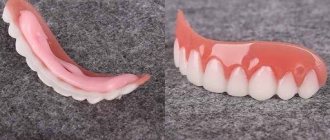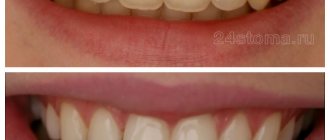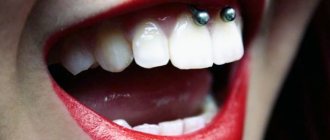Ceramic veneers are microprostheses for restoring the shape of a tooth and changing its color. They provide a long-lasting aesthetic effect that no other whitening method can provide. Due to their unlimited shelf life and high strength, they outperform composite materials used for dental restoration. At the same time, they are installed without traumatic treatment of the teeth, which cannot be avoided when using prosthetics with crowns.
Types of ceramic veneers
Based on the materials used for manufacturing, they are distinguished:
- Porcelain veneers made of pressed and unpressed ceramics. They have excellent aesthetics, adhere well to the teeth, but are not resistant to particularly heavy loads.
- Zirconium dioxide overlays. They consist of a zirconium frame on which a ceramic mass is applied. The material is extremely strong (stronger than metal), but has low adhesive properties (i.e., they are not securely fixed to the teeth).
Based on the thickness, microprostheses are divided into:
- ordinary (their thickness is 1.3-1.5 mm);
- ultranir (from 0.3 to 0.5 mm).
The best manufacturers
Microprostheses made from ceramics from the following manufacturers are widely used in aesthetic dentistry:
- E-max (German lithium silicate glass ceramics of increased strength);
- Empress (very thin and durable reinforced leucide glass ceramic, produced in Liechtenschnein);
- Finesse All Ceramic (American reinforced leucide glass ceramics);
- Cergo (German-made ceramics with a very smooth surface).
Are veneers used on crowns?
“Is it possible to put veneers on a crown?” — this question is so popular among patients that it has to be discussed separately. The answer here is obvious: veneers are NOT used on crowns. These products are self-sufficient, so such a “mix” makes no sense at all. Repair of crowns is possible, although replacement of the product is more often recommended. Crown restoration is carried out both in the laboratory (the crown is removed beforehand) and directly in the patient’s mouth. The whole procedure is reminiscent of a filling, when the damaged area is filled with a composite material. Veneers cannot be repaired: if the lining breaks, it is replaced with a new one. The exception is direct composite veneers, which can theoretically be restored.
"Hollywood" porcelain veneers
Special mention should be made of the so-called “Hollywood” veneers or lumineers (from the English luminary - luminary). These microprostheses have been decorating the smiles of American celebrities for 20 years now. Lumineers were once preferred by George Clooney, Tom Cruise, Angelina Jolie, Gwyneth Paltrow and other stars.
Lumineers are made from the strongest ceramics and are only 0.2-0.3 mm thick. The method of their production is patented and kept secret. These are the only microprosthetic onlays that are fixed to unground teeth.
What is better - veneers or crowns?
Talking about which is better (veneers or crowns) is like comparing a car and a motorcycle. Each of these methods has its own advantages and indications for use. Below is a table that shows situations when it is most preferable to use crowns and when to use veneers.
| Indications for installation of veneers | Indications for crown installation |
|
|
By and large, crowns and veneers have different indications for installation, however, there are situations in which the patient can choose between two products.
Manufacturing and installation
The entire process of prosthetic veneers takes about a week and involves two visits to the dentist.
How are veneers made?
Porcelain veneers can be made in two ways:
- layer-by-layer application and firing of porcelain mass (when working with unpressed ceramics);
- injection molding under the influence of high temperatures and pressure (this is how linings are made from pressed ceramics, which are considered more durable than those made from unpressed ceramics).
Microprostheses made of zirconium dioxide are manufactured using CAD/CAM technology:
- The CAD system creates a three-dimensional model of the overlay using a computer;
- The CAM system allows you to produce microprostheses according to a three-dimensional model on a highly accurate automatic milling machine (without human intervention).
The fastest way to automatically create a veneer from zirconium dioxide is to use the Cerec device (a set of technologies, equipment and materials for the production of ceramic microprostheses).
How are porcelain veneers installed?
Installation includes the following steps:
- Choice of color and type of overlay.
- Odontopreparation (removal of hard tooth tissues). To install conventional veneers and ultra-veneers, it is necessary to grind away from the tooth surface from half to one and a half millimeters. Lumineers are installed without grinding.
- Making an impression of the prepared tooth.
- Fixing a temporary plastic onlay (the ground tooth needs protection from the aggressive environment of the oral cavity while the onlay is being manufactured).
- Laboratory production of veneers based on impressions taken.
- Fastening the microprosthesis.
When installing lumineers, the second and fourth stages are omitted.
Video instructions in Russian Perfect Smile Veneers (Perfect Smile Veneers)
It is quite easy to adapt to wearing an elastic plate. A video instruction in Russian, which can be viewed on the website, will help you correctly install Perfect Smile Veneers. After the first installation, using veneers will be very easy. The process will take a few minutes of your time.
How to use and how to place veneers:
- After purchase, it is recommended to place the plates in hot water.
- Wait about 2 minutes for them to soften.
- Remove the dental veneers from the water.
- Fasten as tightly as possible.
- Wait for the plates to take shape.
- After removal, it is necessary to rinse the device with warm boiled water.
If you follow the instructions correctly, subsequent installation will not take much time. The product is a cosmetic accessory, so it is not advisable to bite into hard food or cause mechanical impact.
Care
Ceramic veneers require the same care as natural teeth. To preserve their aesthetics and extend their service life, it is recommended:
- reduce the consumption of foods with dyes (the linings will not change color, but the fixing cement may);
- wear a plastic mouthguard for bruxism - pathological grinding of teeth;
- do not subject teeth with veneers to increased stress (do not bite ice, do not open bottles, do not bite nails and hair ends, do not shell seeds);
- Do not miss dental checkups (once every six months).
Negative reviews about Perfect Smile Veneers
You can also read negative reviews about veneers on the Internet. On our portal we provide responses to which the manufacturer responds.
I ordered polypropylene plates, delivery was fast. I put them in hot water, but they did not soften, it was impossible to install and wear normally.
Manufacturer's response:
You may have placed the product in water that is not hot enough. Boiling water is used to soften polypropylene. If the purchase was not made through an official online store, the product may not be original. This may be due to the lack of effectiveness.
Service life is about 2 weeks. The pads are torn and it is impossible to eat with them.
Advantages and disadvantages
Advantages:
- high aesthetic effect (ceramics differs from composites in that it retains its original color and, with high-quality processing, is no different from a real tooth);
- biocompatibility (ceramic veneers are hypoallergenic);
- durability (compared to composite onlays, the short-term whitening effect and the five-year service life of a conventional filling);
- minimal or zero treatment of the tooth (the tooth is ground much more strongly for a crown).
Flaws:
- high cost (restoration with composite materials is cheaper);
- instability to heavy loads (can peel off and break);
- irreversibility of the preparation (the tooth ground under the veneer will no longer be able to function normally after the onlay is removed).
When is the best time to install veneers?
- For small defects in the front teeth.
Unlike crowns, veneers require minimal grinding of the teeth, so the tooth retains its anatomical shape. By the way, it is no longer possible to install veneers after crowns; - To hide small interdental spaces and curvatures.
Veneers cope well with such problems and do not require deep tooth preparation.
When restoring chewing teeth, crowns should be installed, as they cope well with the chewing load. Veneers are placed on molars if they want to get an additional lifting effect for the lower third of the face.
CONTRAINDICATIONS. WHO IS VENEERS SUITABLE FOR?
Like any other medical procedure, the installation of ceramic veneers has contraindications. It is worth refusing to use microprostheses:
1. In the presence of caries and other untreated dental diseases. This restriction is temporary.
2. In case of significant destruction of tooth dentin and large fillings installed.
3. In the presence of bruxism.
Before starting treatment, the orthodontist must conduct a thorough examination of the patient to exclude the presence of the listed contraindications.
Indications for installation of veneers
- Slight crooked teeth.
- Chips, cracks in enamel.
- Darkening, yellow spots on the teeth.
- Too wide or narrow interdental spaces.
- Pathological abrasion of enamel.
- Increased sensitivity of teeth.
IMPORTANT! However, before you find out how much veneers cost, get examined by a podiatrist. Installation is not possible if you have significant malocclusions - otherwise the veneers may simply crack when chewing.
Budget analogue - composite veneers
There is an easier and faster way to restore teeth. Composite veneers help with this - a polymer in the form of a paste that is applied directly to the surface of the tooth. The composition is mixed in the dentist's office, which allows you to complete the procedure in one visit. Of course, if there is no need for preliminary treatment of teeth and soft tissues.
The composite has good aesthetics and does not require significant grinding of natural teeth. Hardening is carried out layer by layer, under the influence of light flux. This provides the necessary strength to microprostheses. The technique is suitable for restoring lateral teeth.
Disadvantages of polymer restoration:
- Shorter service life compared to ceramic veneers - no more than 5-6 years.
- Instability to pigmentation. The material changes color over time and absorbs coloring components.
- Imperfect match to the shade of natural enamel.










